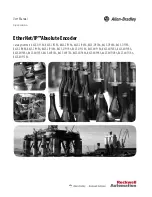
Rockwell Automation Publication 842E-UM001C-EN-P - September 2016
11
Chapter
2
Encoder Overview
The 842E family of encoders uses EtherNet/IP technology to provide its data
to a programmable controller. These encoders include an embedded
EtherNet/IP switch to connect additional EtherNet/IP capable products in
series and/or support a Device Level Ring (DLR) topology for Ethernet media
redundancy.
The 842E is an ultra-high resolution encoder in single-turn and multi-turn
versions. These encoders have 18-bit single-turn resolution. The multi-turn has
an additional 12 bits for counting the number of revolutions.
Overview of the Encoder
What Is an Encoder?
Encoders can electronically monitor the position of a rotating shaft to measure
information such as speed, distance, RPM, and position. Rockwell
Automation® offers various light- and heavy-duty incremental and absolute
encoders. Our accessories help you easily install and efficiently use our
encoders.
What Are the Different Kinds of Encoders?
Incremental
A simple and cost-effective solution for a wide variety of applications,
incremental encoders electronically monitor the position or speed of a rotating
shaft. Encoder feedback is compatible with programmable controllers,
numerical controllers, motion controllers, and other position systems.
Rockwell Automation® offers light-duty and heavy-duty incremental encoders
for different shaft loads. Ruggedized incremental encoders are available with an
enclosure rating of NEMA Type 4 and IP66. Incremental encoders are also
available in solid and hollow shaft models for various mounting options.
Applications include: machine tools, packaging machinery, motion controls,
robotics, and DC drives.
Absolute
An absolute encoder has a unique digital output for each shaft position. The
use of absolute encoders assures that true position is always available, regardless
of power interruptions to the system. Absolute encoders can be single-turn or
multi-turn.












































